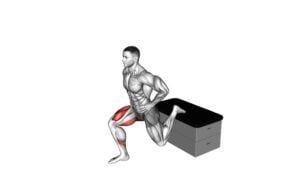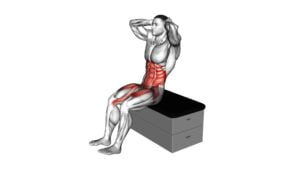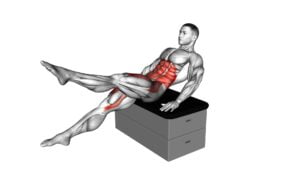Squat on a Padded Stool (Male) – Video Exercise Guide & Tips

Looking to amp up your leg workout? Get ready to squat on a padded stool!
Watch This Exercise Video
In this video exercise guide, we'll show you the benefits of this variation and provide tips for proper form.
Avoid common mistakes and learn how to increase intensity for maximum results.
Plus, we'll cover safety precautions to keep you injury-free.
So grab a stool, hit play, and get ready to take your squats to the next level!
Key Takeaways
- Engages multiple muscle groups simultaneously
- Targets quadriceps, hamstrings, and glutes
- Improves stability and balance
- Proper form and technique are crucial for injury prevention and effectiveness
Benefits of Squatting on a Padded Stool
Experience the numerous benefits of squatting on a padded stool to enhance your lower body strength and stability. Squatting on a padded stool provides several advantages for your workout routine.
Firstly, it helps to improve your overall lower body strength by engaging multiple muscle groups simultaneously. This exercise primarily targets your quadriceps, hamstrings, and glutes, but also activates your calves and core muscles. By incorporating squats on a padded stool into your routine, you can effectively build and tone these muscle groups, leading to increased strength and power.
In addition to strengthening your lower body, squatting on a padded stool also improves your stability and balance. The padded stool provides a stable surface to perform your squats, allowing you to focus on maintaining proper form throughout the exercise. This helps to develop your proprioception, or the awareness of your body's position in space, which is crucial for overall balance and coordination.
Moreover, squatting on a padded stool reduces the impact on your joints compared to traditional squats on the ground. The cushioning provided by the stool helps to absorb some of the shock and stress that would otherwise be placed on your knees and ankles. This makes squats on a padded stool a safer option for individuals with joint issues or those looking to prevent injuries.
Setting up the Padded Stool
To set up the padded stool for your squatting exercises, you'll need to follow these steps:
- Adjust the height: Position the stool at a height that allows your knees to bend at a 90-degree angle when you squat. This will ensure proper form and prevent strain on your joints.
- Place the stool on a stable surface: Make sure the stool is placed on a flat and stable surface to prevent any wobbling or tipping over during your workout.
- Secure the padding: Ensure that the padding on the stool is secure and in good condition. This will provide comfort and support during your squats.
- Test the stability: Before starting your workout, give the stool a gentle shake to check its stability. If it feels unstable or wobbly, adjust the height or find a more stable stool.
- Modifications for beginners: If you're a beginner, consider starting with a lower height or using additional support, such as holding onto a sturdy object or using resistance bands. These modifications will help you build strength and stability as you progress.
Proper Form for the Squat on a Padded Stool
To perform the Squat on a Padded Stool with proper form, it's crucial to pay attention to two key points: knee alignment and stability, as well as stool height and comfort.
Maintaining proper knee alignment is essential to prevent injury and maximize the effectiveness of the exercise.
Additionally, adjusting the stool height and ensuring comfort will allow you to perform the squat with ease and maintain proper form throughout the movement.
Knee Alignment and Stability
For proper form and stability when performing the squat on a padded stool, focus on aligning your knees. Proper knee alignment is crucial to prevent injuries and maximize the effectiveness of the exercise.
Here are some techniques to ensure proper knee alignment:
- Keep your knees in line with your toes throughout the movement.
- Avoid letting your knees collapse inward or extend past your toes.
- Engage your glutes and core muscles to stabilize your knees.
- Maintain a neutral spine position to support proper knee alignment.
- Practice stability exercises, such as single-leg squats or balance training, to improve knee stability.
Stool Height and Comfort
As you adjust the stool height for the squat on a padded stool, make sure to maintain proper form and prioritize your comfort. Stool height considerations are crucial for ensuring an effective and safe workout.
When setting the height, aim for a position where your knees are at a 90-degree angle when you're in the squat position. This ensures proper alignment and reduces the risk of injury.
Additionally, choose a stool height that allows you to maintain a comfortable posture throughout the exercise. Ergonomic benefits come into play here – the right stool height can help reduce strain on your joints and muscles, enhancing your overall squatting experience.
With the appropriate stool height, you can fully engage your lower body muscles and achieve optimal results.
Now, let's explore some common mistakes to avoid while performing the squat on a padded stool.
Common Mistakes to Avoid
To ensure you perform the squat on a padded stool correctly and avoid common mistakes, it's important to pay attention to proper form and injury prevention techniques.
By following a proper form demonstration, you'll learn how to engage the correct muscles and maintain proper alignment throughout the exercise.
Additionally, implementing injury prevention techniques, such as avoiding excessive forward lean or rounding of the back, will help protect your joints and reduce the risk of injury.
Proper Form Demonstration
Avoiding common mistakes is crucial when demonstrating proper form for squatting on a padded stool. To ensure you're performing the exercise correctly, keep in mind the following tips:
- Maintain proper technique by keeping your feet shoulder-width apart and pointing slightly outward.
- Keep your back straight and chest lifted throughout the movement.
- Engage your core muscles to stabilize your body during the squat.
- Control the descent by lowering your hips back and down, as if sitting on a chair.
- As you rise back up, push through your heels and activate your glutes and thighs.
By following these guidelines, you can perform squats on a padded stool with proper form, maximizing the benefits of the exercise while minimizing the risk of injury.
Now let's move on to the next section, where we'll discuss injury prevention techniques.
Injury Prevention Techniques
To prevent injuries and avoid common mistakes, focus on proper form when squatting on a padded stool. Incorporating injury prevention exercises and warm-up techniques into your routine can significantly reduce the risk of injury.
Before starting your squatting exercise, it's essential to warm up your muscles and joints. Dynamic stretches like leg swings and hip circles can help increase blood flow and improve flexibility. Additionally, performing exercises that target the muscles involved in squatting, such as lunges and glute bridges, can help strengthen and prepare your body for the movement.
When squatting on a padded stool, make sure to maintain proper alignment, keeping your knees in line with your toes and your back straight. Avoid rounding your back or allowing your knees to collapse inward.
Tips for Increasing Intensity and Progression
Increase the intensity and progression of your squat on a padded stool by incorporating these tips:
- Increase Resistance: To challenge your muscles further, add weights or resistance bands to your squat routine. This will help build strength and increase the difficulty of the exercise.
- Try Advanced Workout Options: Once you have mastered the basic squat on a padded stool, you can explore advanced variations such as pistol squats or jump squats. These exercises engage different muscle groups and enhance overall fitness.
- Focus on Form: Proper form is essential for maximizing the effectiveness of your squats. Maintain a neutral spine, engage your core, and ensure that your knees are in line with your toes. This will prevent injuries and optimize muscle engagement.
- Gradually Increase Reps and Sets: As you become more comfortable with the exercise, gradually increase the number of repetitions and sets. This will help improve endurance and overall strength.
- Incorporate Plyometric Exercises: Plyometric exercises, such as squat jumps or box jumps, can be incorporated into your squat routine to further enhance intensity and explosive power.
Safety Precautions and Injury Prevention
To ensure your safety and prevent injuries while performing the squat on a padded stool, it's important to follow these essential guidelines.
First and foremost, always warm up before starting any exercise routine. This helps to increase blood flow to the muscles, improve flexibility, and reduce the risk of injury. Start with a few minutes of light cardio, such as jogging or jumping jacks, followed by dynamic stretches to activate the muscles you'll be using during the squat.
When performing the squat on a padded stool, it's crucial to maintain proper form. Keep your feet shoulder-width apart, toes pointing slightly outward. As you lower yourself down, focus on keeping your knees aligned with your toes and your back straight. Avoid rounding your shoulders or letting your knees extend beyond your toes, as this can put unnecessary strain on the joints.
Additionally, it's important to start with a weight that you can handle comfortably. Gradually increase the weight as your strength and form improve. Always listen to your body and stop if you experience any pain or discomfort. Remember to breathe properly throughout the exercise, inhaling as you lower yourself down and exhaling as you push back up.
Frequently Asked Questions
How Long Should I Hold the Squat Position on the Padded Stool?
When squatting on a padded stool, it's recommended to hold the squat position for a duration that feels comfortable for you.
The benefits of squatting on a padded stool include reduced strain on your joints and increased stability.
This exercise can help improve your lower body strength and balance.
Remember to listen to your body and gradually increase the duration as you become more comfortable and confident in the exercise.
Can I Use a Regular Stool Instead of a Padded Stool for This Exercise?
Yes, you can use a regular stool instead of a padded stool for this exercise. However, using a padded stool has its benefits.
The padding provides extra comfort and support, reducing strain on your joints. It also helps to maintain proper posture and stability during the squat.
Is It Necessary to Warm up Before Performing the Squat on a Padded Stool?
It's important to warm up before performing the squat on a padded stool. Warming up helps increase blood flow to your muscles and prepares them for the exercise. It also reduces the risk of injury.
As for variations of the squat on a padded stool, you can adjust the height of the stool or add weights to increase the intensity. Remember to listen to your body and start with a comfortable level before progressing.
What Muscles Does the Squat on a Padded Stool Primarily Target?
The squat on a padded stool primarily targets your quadriceps, hamstrings, and glutes. By using a padded stool, you can benefit from added stability and support during the exercise. This can help prevent strain on your joints and reduce the risk of injury.
However, it's important to avoid common mistakes such as leaning too far forward or allowing your knees to go past your toes. Remember to maintain proper form and engage your core for optimal results.
How Often Should I Incorporate the Squat on a Padded Stool Into My Workout Routine?
To determine how often you should incorporate the squat on a padded stool into your workout routine, consider your fitness goals and current exercise regimen. Squat variations offer numerous benefits, such as strengthening your lower body muscles and improving balance.
It's generally recommended to include squats in your routine at least 2-3 times per week, allowing for proper rest and recovery.
However, it's important to consult with a fitness professional to tailor a plan that suits your specific needs and abilities.
Conclusion
In conclusion, squatting on a padded stool offers numerous benefits, including improved stability and reduced strain on the joints.
By setting up the stool correctly and maintaining proper form, you can maximize the effectiveness of this exercise.
It's crucial to avoid common mistakes and gradually increase intensity for better results.
Lastly, always prioritize safety precautions and injury prevention to ensure a safe and successful workout experience.

Author
Years ago, the spark of my life’s passion ignited in my mind the moment I stepped into the local gym for the first time. The inaugural bead of perspiration, the initial endeavor, the very first surge of endorphins, and a sense of pride that washed over me post-workout marked the beginning of my deep-seated interest in strength sports, fitness, and sports nutrition. This very curiosity blossomed rapidly into a profound fascination, propelling me to earn a Master’s degree in Physical Education from the Academy of Physical Education in Krakow, followed by a Sports Manager diploma from the Jagiellonian University. My journey of growth led me to gain more specialized qualifications, such as being a certified personal trainer with a focus on sports dietetics, a lifeguard, and an instructor for wellness and corrective gymnastics. Theoretical knowledge paired seamlessly with practical experience, reinforcing my belief that the transformation of individuals under my guidance was also a reflection of my personal growth. This belief holds true even today. Each day, I strive to push the boundaries and explore new realms. These realms gently elevate me to greater heights. The unique combination of passion for my field and the continuous quest for growth fuels my drive to break new ground.







